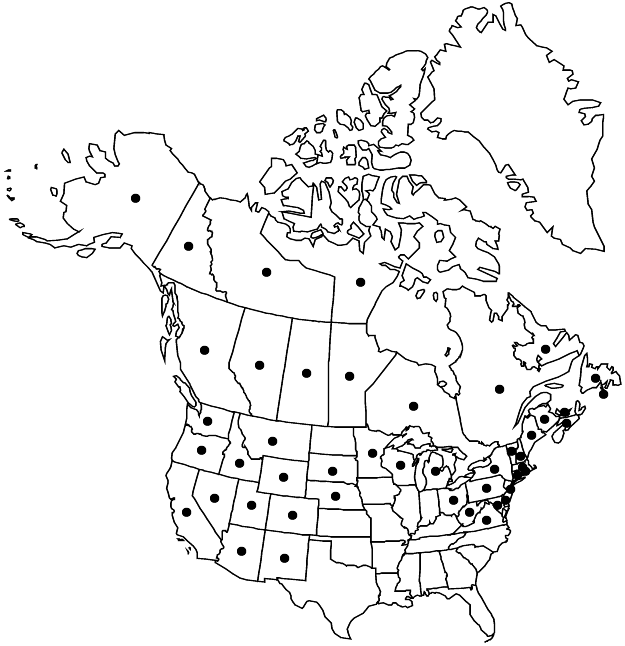Pyrola chlorantha
Kongl. Svenska Vetensk. Akad. Nya Handl. 31: 190, plate 5. 1810 ,.
Plants rhizomatous, (0.7–) 1.4–2.2 (–2.7) dm. Leaves sometimes reduced or absent; petiole 8–60 mm, channeled adaxially, glabrous; blade not or, rarely, obscurely maculate, dull and light green to purplish abaxially, shiny and dark green, rarely with white tissue bordering larger veins adaxially, ovate, elliptic, obovate, or round, (6–) 18–28 (–33) × (5–) 10–30 mm, coriaceous, base rounded to truncate or decurrent, margins entire or crenulate to crenulate-serrulate, apex obtuse to rounded. Inflorescences 1–2 (–3) per stem, (1–) 2–8 (–17) -flowered; peduncular bracts absent or 1 (–2), subulate to linear-lanceolate, 2.8–5 × 0.5–0.8 mm, membranous, margins entire or erose-denticulate; inflorescence bracts subulate to lanceolate, usually shorter than, rarely longer than, subtended pedicels, (2.3–) 3–5 (–7.7) × 0.5–0.8 mm, membranous. Pedicels 3–8 mm. Flowers: calyx lobes appressed or spreading in fruit, green or pinkish with margins hyaline to white, deltate to deltate-ovate, (0.9–) 1.2–1.7 × (0.9–) 1.3–1.9 mm, margins entire or obscurely erose-denticulate, apices acute to obtuse; petals greenish white to yellowish white, obovate, (4–) 4.5–9 × 3.3–5.5 mm, margins entire or obscurely erose-denticulate; stamens 4–7.5 mm; filament base 0.7–1.2 mm wide; anthers (2.1–) 2.5–3 (–3.7) mm, apiculations absent or less than 0.1 mm, thecae creamy white or tan to yellowish, tubules yellowish-brown, 0.7–1.1 mm, abruptly narrowed from thecae, lateral walls not touching or connivent distally, pores 0.2–0.4 × 0.1–0.2 mm; ovary smooth; style exserted, (4–) 5–7 mm; stigma 0.9–1.5 mm wide, lobes erect. Capsules depressed-globose, 3–4.5 × 3.5–6.4 mm. 2n = 46.
Phenology: Flowering Jun–Aug.
Habitat: Moist to dry, coniferous and deciduous forests
Elevation: 10-3700 m
Distribution

St. Pierre and Miquelon, Alta., B.C., Man., N.B., Nfld. and Labr., N.W.T., N.S., Nunavut, Ont., P.E.I., Que., Sask., Yukon, Alaska, Ariz., Calif., Colo., Conn., Del., Idaho, Maine, Md., Mass., Mich., Minn., Mont., Nebr., Nev., N.H., N.J., N.Mex., N.Y., Ohio, Oreg., Pa., R.I., S.Dak., Utah, Vt., Va., Wash., W.Va., Wis., Wyo., Europe
Discussion
E. Haber (1993) interpreted some herbarium specimens with intermediate morphologies and abnormal pollen as putative hybrids between Pyrola chlorantha and P. minor, and between P. chlorantha and P. picta. Leafless forms of P. chlorantha can be distinguished reliably from those of P. picta by the size and shape of the calyx lobes.
Selected References
None.
Lower Taxa
"dm" is not declared as a valid unit of measurement for this property.